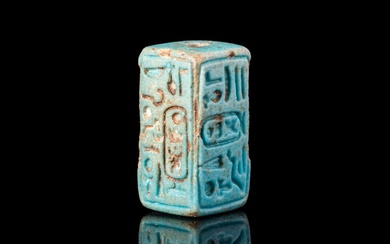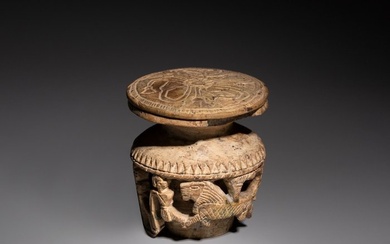Egyptian Old Kingdom Glazed Faience Tiles (pr)
**Holiday Shipping Deadlines**
USA Domestic: 12/14 for Standard; 12/23 for Express; International: 12/7 for Standard; 12/19 for Express
Ancient Egypt, Old Kingdom, Third Dynasty, ca. 2630 to 2611 BCE. A turquoise glazed faience tile, one of the over thirty-thousand faience tiles found in the funerary complex of the Pharaoh Djoser; also a sky blue glazed faience tile of a similar style that was probably used in a temple or tomb nearby. The turquoise tile has a square tab at the back for attachment, while the blue tile has a groove. Djoser's funerary complex was located at Saqqarah (Saqqara), northwest of Memphis, and included the Step Pyramid that was Egypt's first pyramid and is the oldest preserved stone building of its size in the world. Buried underneath the pyramid was a maze of rooms and a burial chamber; part of this was a long hallway lines with artwork showing the king engaging in rituals. Framed around them were these tiles; we believe that they were meant to imitate reed matting from the walls of Djoser's palace. The purpose of this was to bring the king into a paradise in the afterlife, and the blue color of the tile to call to mind water, a symbol of rebirth in ancient Egypt because of the cycle of the Nile. Size of largest (turquoise): 1.45" W x 2.25" H (3.7 cm x 5.7 cm); 2.9" H (7.4 cm) on included custom stand.
The manufacture of so many tiles would have required extensive kilns, not to mention a tremendous amount of time and manpower. They are made of faience, which is a crushed quartz mix that could be moistened to shape and then heated to harden. Copper salts, turquoise stone, and other color materials were added to give these tiles (and all faience items) their color.
Provenance: private J.H. collection, Beaverton, Oregon, USA, acquired in February 2009 (blue) and March 2009 (turquoise); (blue) ex-Windsor Antiquities, New York, USA; (turquoise) ex-Medusa Ancient Art, Montreal, Quebec, Canada; ex-private collection, acquired on the European Art Market
All items legal to buy/sell under U.S. Statute covering cultural patrimony Code 2600, CHAPTER 14, and are guaranteed to be as described or your money back.
A Certificate of Authenticity will accompany all winning bids.
We ship worldwide to most countries and handle all shipping in-house for your convenience.
#151268
Condition Report: The more blue of the two has some losses to its upper and lower edges. Both have wear commensurate with age including some small scratches and chips to the glaze.
View it on
Estimate
Time, Location
Auction House
**Holiday Shipping Deadlines**
USA Domestic: 12/14 for Standard; 12/23 for Express; International: 12/7 for Standard; 12/19 for Express
Ancient Egypt, Old Kingdom, Third Dynasty, ca. 2630 to 2611 BCE. A turquoise glazed faience tile, one of the over thirty-thousand faience tiles found in the funerary complex of the Pharaoh Djoser; also a sky blue glazed faience tile of a similar style that was probably used in a temple or tomb nearby. The turquoise tile has a square tab at the back for attachment, while the blue tile has a groove. Djoser's funerary complex was located at Saqqarah (Saqqara), northwest of Memphis, and included the Step Pyramid that was Egypt's first pyramid and is the oldest preserved stone building of its size in the world. Buried underneath the pyramid was a maze of rooms and a burial chamber; part of this was a long hallway lines with artwork showing the king engaging in rituals. Framed around them were these tiles; we believe that they were meant to imitate reed matting from the walls of Djoser's palace. The purpose of this was to bring the king into a paradise in the afterlife, and the blue color of the tile to call to mind water, a symbol of rebirth in ancient Egypt because of the cycle of the Nile. Size of largest (turquoise): 1.45" W x 2.25" H (3.7 cm x 5.7 cm); 2.9" H (7.4 cm) on included custom stand.
The manufacture of so many tiles would have required extensive kilns, not to mention a tremendous amount of time and manpower. They are made of faience, which is a crushed quartz mix that could be moistened to shape and then heated to harden. Copper salts, turquoise stone, and other color materials were added to give these tiles (and all faience items) their color.
Provenance: private J.H. collection, Beaverton, Oregon, USA, acquired in February 2009 (blue) and March 2009 (turquoise); (blue) ex-Windsor Antiquities, New York, USA; (turquoise) ex-Medusa Ancient Art, Montreal, Quebec, Canada; ex-private collection, acquired on the European Art Market
All items legal to buy/sell under U.S. Statute covering cultural patrimony Code 2600, CHAPTER 14, and are guaranteed to be as described or your money back.
A Certificate of Authenticity will accompany all winning bids.
We ship worldwide to most countries and handle all shipping in-house for your convenience.
#151268
Condition Report: The more blue of the two has some losses to its upper and lower edges. Both have wear commensurate with age including some small scratches and chips to the glaze.






